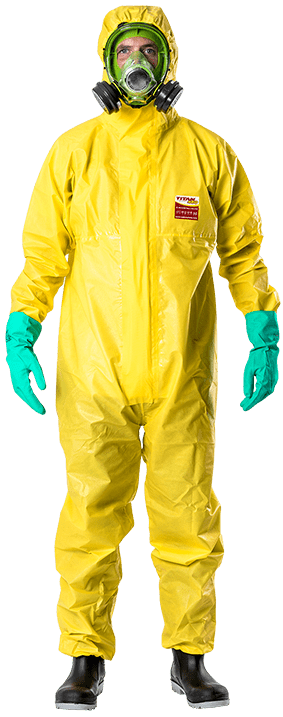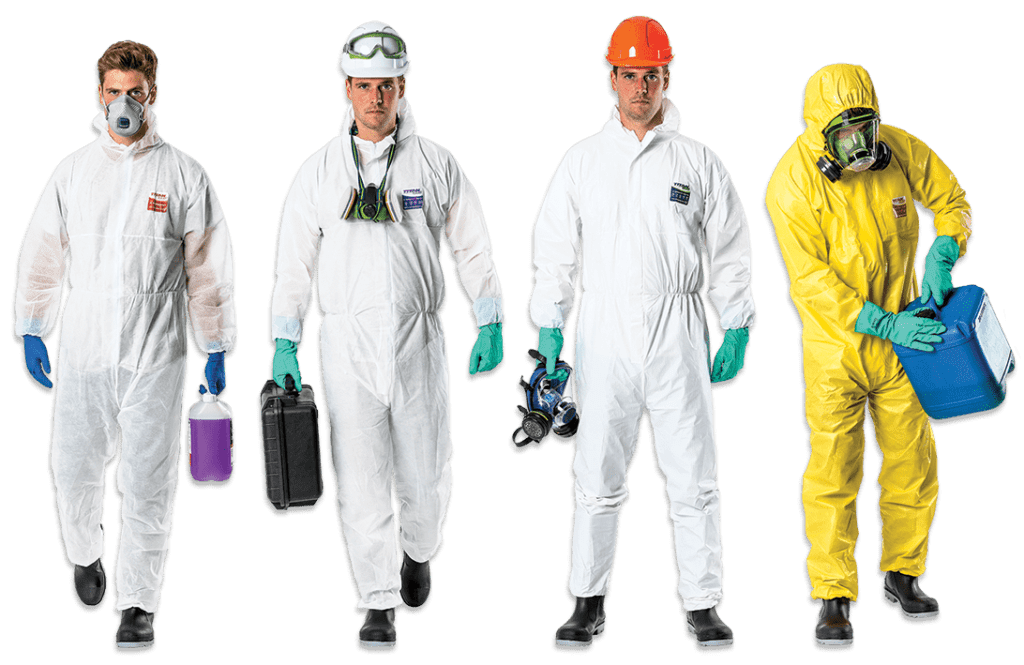Workwear Protection Guide

ESKO COVERALLS
Where workplace hazards cannot be eliminated or isolated, employers are responsible to provide employees with suitable clothing to protect from a variety of hazards including nuisance dust, asbestos fibres, chemical and water-based splashes, chemical sprays, biological hazards, infective agents and simple dirt, grease, and dust.
Even in non-hazardous situations overalls protect the user’s clothing from soiling and wear. It is not necessarily a requirement under the Health and Safety in Employment Act for employers to provide overalls in non-hazardous situations, but many do so.
Disposable coveralls have some advantages over traditional fabric overalls:
- Disposable coveralls can be disposed of after use to avoid cross-contamination from any residues or, if necessary, can be incinerated. In medical situations they avoid any need for re-sterilisation after use.
- Low-cost single-use coveralls may be more economic. Disposable coveralls avoid laundry costs in situations where soiling may be difficult to remove with washing, such as paint, crude oil or grease residues.
- Lightweight coveralls are breathable and comfortable, allowing freedom of movement to bend and stretch and avoiding heat stress for the wearer.
Esko protective coveralls have been tested for breakthrough time of permeation to a range of chemicals. Permeation refers to the process by which a chemical compound moves through protective fabric on a molecular level. Permeation tests for our protective coveralls have been conducted according to EN374-3.
In critical situations and especially when dealing with infectious agents, wearers must be instructed in correct methods of donning and doffing protective coveralls, see Esko’s downloadable product guide.
Esko coveralls Product selection by industry

Esko coveralls product selection by industry | ||||
|---|---|---|---|---|
USEFUL FOR: | Need protection against non-hazardous liquids or dust? | Do you need protection against hazardous dust including asbestos and glass fibre? | Protection against hazardous dust including asbestos, or liquid chemical splashes, or biological hazards, including Ebola? | Need protection against pressurised liquid chemical sprays, liquid aerosols or severe biological hazards and infective agents? |
Aerospace | ||||
Agriculture & Farming | ||||
Asbestos Handling | ||||
Biological Hazards | ||||
Automotive | ||||
Chemical Handling | ||||
Civil Protection | ||||
Clean Room | ||||
Construction | ||||
Decontamination | ||||
Disease/ Disaster Management | ||||
Decorative work | ||||
Electronics | ||||
Food Processing & Packing | ||||
Hazardous Material | ||||
Industrial Clean Up/ Maintenance | ||||
Medical/ Emergency | ||||
Military | ||||
Oil Handling/ Tank Cleaning | ||||
Oil refining/ Exploration | ||||
Paint Spray | ||||
Petrochemical Plants | ||||
Printing | ||||
Sewage Purification Installation | ||||
Utilities | ||||
Waste Management |
Fabric Physical Properties | Test Method | Result | Class | Result | Class | Result | Class | ||
Abrasion Resistance |
EN530 | >100* | 2 | >100* | 2 | >100* | 2 | ||
Flex Cracking Resistance | ISO 7854 B | >40,000* | 5 | >40,000* | 5 | >1,000* | 1 | ||
Trapezoidal Tear Resistance | MD | EN ISO
9073-4
| 44.2N | 3 | 40.7N | 3 | 53N | 3 | |
CD | 19.0N | 1 | 18.6N | 1 | 71N | 3 | |||
Tensile Strength | MD | ISO 13934-1
| 113.5N | 3 | 48.3N | 1 | 82N | 2 | |
CD | 44.5N | 1 | 108.1N | 3 | 121N | 2 | |||
Resistance to ignition | EN13274-4 | Pass | Pass | Pass | |||||
Puncture Resistance | EN863 | 9.7N | 1 | 6.95N | 1 | 9N** | 1 | ||
Seam Strength | ISO13935-2 | 133.0N | 4 | 120.2N | 3 | 108.2N | 3 | ||
Burst Resistance | ISO13938-1 | 184.1kPa | 3 | ||||||
Antistaticity | EN1149-5
| Pass | Pass | Pass | |||||
pH value | EN ISO 3071
| 6.2 | Pass | 6.77 | Pass | 6.76 | Pass | ||
Flame Retardant | EN ISO
14116:2008 | ||||||||
Note: * denotes visual endpoint | |||||||||
Fabric Chemical
Properties | Test Method | Penetration | Repellency | Penetration | Repellency | Penetration | Repellency | ||
Resistance to Chemical Penetration | EN368 | ||||||||
Sulphuric Acid 30% | Class 3 | Class 3 | Class 3 | Class 3 | Class 3 | Class 3 | |||
Sodium Hydroxide 10% | Class 3 | Class 3 | Class 3 | Class 3 | Class 3 | Class 3 | |||
ISO propanol | Class 3 | Class 2 | |||||||
o-Xylene | Class 3 | Class 2 | |||||||
Bulan-1-ol | Class 3 | Class 2 | |||||||
Resistance to
Chemical Permeation | EN374-3 | Breakthrough Time | Classification | ||||||
Sulphuric Acid 30% | >480 mins | Class 6 | |||||||
Sodium Hydroxide 42% | >480 mins | Class 6 | |||||||
Methanol | >480 mins | Class 6 | |||||||
Sulphuric Acid 98% | >480 mins | Class 6 | |||||||
Formaldehyde 10% | 14 mins | Class 6 | |||||||
Acetic Acid | >480 mins | Class 1 | |||||||
Chromic Acid 80% | >480 mins | Class 6 | |||||||
Dimethyl Formamide | >480 mins | Class 6 | |||||||
Hydrochloric Acid 37% | 15 mins | Class 1 | |||||||
Nitric Acid 65% | 273 mins | Class 5 | |||||||
Perchloric Acid | >480 mins | Class 6 | |||||||
Potassium Chromate | >480 mins | Class 6 | |||||||
Whole suit test performance | Test Method | Result | Test Method | Result | Test Method | Result | |||
TYPE 5 EN ISO 13982-1:2004 Method as defined by EN ISO 13982-2:2004 | Pass | TYPE 5 EN ISO 13982-1:2004 Method as defined by EN ISO 13982-2:2004 | Pass | TYPE 3 let test Method defined by EN14605:2005 + EN463 | Pass | ||||
TYPE 6 Low Level Spray Test Method as defined by EN 13034:2005 + EN468 | Pass | TYPE 6 Low Level Spray Test Method as defined by EN 13034:2005 + EN468 | Pass | TYPE 4 Spray test Method defined by EN14605:2005 + EN468 | Pass | ||||
Protective clothing against radioactive materials as defined by EN1073-2:2002 | Pass | Protective clothing against radioactive materials as defined by EN1073-2:2002 | Pass | Protective clothing against radioactive materials as defined by EN1073-2:2002 | Pass | ||||
Performance of protective clothing against infective agents EN14126:2003 | EN14126:2003 | EN14126:2003 | |||||||
ISO 16603:2004 | Class 6 | Class 6 | |||||||
IOS 16604:2004 | Class 1 | Class 6 | |||||||
ISO 22611:2003 | Class 3 | Class 3 | |||||||
ISO 22612:2005 | Class 3 | Class 3 | |||||||
ISO 22610:2006 | Class 6 | Class 6 | |||||||
RELEVANT STANDARDS
- EN ISO 13982-1:2004+A1:2010 Protective clothing for use against solid particulates
- EN 14126:2003 Protective clothing. Performance requirements and tests methods for protective clothing against infective agents
- EN 14605:2005+A1:2009 Protective clothing against liquid chemicals
- EN 13034: 2005 Protective clothing against liquid chemicals
- EN 1073-2:2002 Protective clothing against radioactive contamination